Navratri Nights : 10 Stunning Garba Outfits for Dance Enthusiasts
As Navratri approaches, the anticipation for the vibrant Garba nights grows. For those unfamiliar, Garba is a traditional Indian dance hailing from Gujarat, performed during the nine-night Navratri festival, dedicated to goddess Durga. This graceful dance involves circling movements, creating a colourful spectacle.
Navratri Nights : 10 Stunning Garba Outfits for Dance Enthusiasts
Traditional Chaniya Choli:
The “Traditional Chaniya Choli” is a culturally rich and intricate ensemble deeply rooted in the traditions of Gujarat, a western state in India. This traditional outfit is predominantly worn by women during various festive and celebratory occasions, most notably during Navratri, one of Gujarat’s most vibrant and lively festivals.
The Chaniya, also known as a Lehenga, is the lower component of the outfit. It is a full, flared skirt characterised by its exuberant colours, detailed embroidery, mirror work, and elaborate embellishments. Each Chaniya is a masterpiece of artistry, reflecting the indigenous craftsmanship and cultural heritage of Gujarat.
Pattern of Traditional Chaniya Choli:
The pattern of a Traditional Chaniya Choli typically follows a specific design and structure, reflecting the cultural and artistic heritage of Gujarat, India. Here are the key elements and patterns that define this traditional attire:
Chaniya (Lehenga) Pattern:
- Full Flare: The Chaniya, or Lehenga, is a full, flared skirt that gives a circular, voluminous appearance. It is designed to allow easy movement and dancing.
- Intricate Embroidery: Elaborate and colourful embroidery is a hallmark of the Chaniya. Traditional motifs, such as peacocks, elephants, and flowers, are often featured in the embroidery work.
- Mirror Work: Mirrors are commonly used to add shimmer and reflection to the outfit. These mirrors are typically hand-sewn onto the fabric.
- Vibrant colours: Chaniyas are known for their bold and lively colours, which are often a mix of bright shades like red, green, blue, and yellow.
- Choli (Blouse) Pattern:
- Fitted Silhouette: The Choli is a fitted blouse that complements the Chaniya. It can have various sleeve lengths, including short, long, or even off-shoulder styles.
- Matching/Contrasting Design: The Choli’s design, including its embroidery and embellishments, is chosen to either match or contrast with the Chaniya’s patterns and colours.
- Backless Cholis: Some Cholis feature a stylish backless design, adding a modern touch to the traditional outfit.
- Dupatta (Scarf):
- Coordination: A coordinating Dupatta or scarf is often paired with the Chaniya Choli. It is draped elegantly to complete the outfit.
- Embroidery: The Dupatta may also feature similar embroidery and mirror work as the Chaniya and Choli.
- Accessories:
- Statement Jewellery: Women often accessorise their Traditional Chaniya Choli with statement jewellery, such as oxidised silver or gold ornaments.
- Maang Tikka: A Maang Tikka, a decorative headpiece, is a popular accessory to complete the traditional look.
Styling Secrets for Traditional Chaniya Choli
Styling a Traditional Chaniya Choli is an exciting opportunity to embrace the vibrant and traditional attire of Gujarat, India. Here’s a guide on how to style it effectively:
- Choose the Right Traditional Chaniya Choli: Begin by selecting a Traditional Chaniya Choli that suits your body type and the occasion. Pay attention to the colours, fabric, and intricate details.
- Blouse Selection: The blouse is a key element of the outfit. You can opt for a matching or contrasting blouse, considering various styles like backless, full-sleeved, or off-shoulder to add a modern touch.
- Draping the Chaniya: Put on the Choli and then step into the Chaniya (skirt). Pull it up to your waist and secure it comfortably. Make sure it’s evenly flared around you.
- Accessories: Traditional jewellery enhances the Traditional Chaniya Choli. Consider statement earrings, necklaces, bangles, and a maang tikka that match the outfit’s colour and design.
Lehenga Style Saree:
A Lehenga Style Saree is a contemporary and versatile Indian outfit that has gained immense popularity among women seeking a blend of traditional elegance and modern comfort. This unique ensemble fuses the classic elements of a saree and a lehenga, offering the best of both worlds.
Key features of a Lehenga Style Saree include:
- Pre-Draped Saree: Unlike a traditional saree that requires intricate draping, a Lehenga Style Saree comes pre-pleated and stitched, making it relatively easier to wear. This aspect appeals to women who may not be well-versed in the art of saree draping.
- Lehenga-Inspired Skirt: The lower half of the outfit resembles a lehenga, with a flared skirt that can be worn like a regular skirt. It often features intricate embroidery, embellishments, and vibrant colours, similar to traditional lehengas.
- Pallu Design: The pallu, or the loose end of the saree, is draped over one shoulder and pinned or tucked into place. This creates the saree’s signature look while providing convenience and ease of movement.
- Blouse Options: Lehenga Style Sarees come with a matching or contrasting blouse, which can be customised to various styles, including backless, off-shoulder, or full-sleeved, to suit individual preferences.
- Versatility: This attire is suitable for a wide range of occasions, from weddings and festivals to formal events and parties. It offers a balance between traditional and contemporary fashion.
- Accessories: Women often pair Lehenga Style Sarees with statement jewellery, such as necklaces, earrings, bangles, and hair accessories, to enhance their overall look.
Pattern of Lehenga Style Saree:
The pattern of a Lehenga Style Saree is a delightful blend of traditional and contemporary elements, offering a visually striking and versatile ensemble. Here are the key components that define the pattern of this attire:
Saree Drape:
The Lehenga Style Saree comes pre-draped, with the pallu (the loose end) already attached to the skirt. This allows for a simpler and quicker wearing process compared to a traditional saree.
Skirt Design:
The lower half of the outfit resembles a lehenga, characterised by a flared, A-line or circular skirt. It is typically shorter than a full-length lehenga and provides ease of movement.
Pleats and Drapes:
The pleats of the saree are neatly pre-arranged and stitched into place, eliminating the need for intricate pleating. The pallu is draped over one shoulder and then pinned or tucked in place to achieve the classic saree look.
Mastering Lehenga Style Saree Styling with Finesse
Styling a Lehenga Style Saree is an opportunity to showcase the elegance of a traditional saree while benefiting from the comfort and convenience of a lehenga-style outfit. Here’s how to style it effectively:
Choose the Right Lehenga Style Saree:
Start by selecting a Lehenga Style Saree that complements your body shape and the occasion. Pay attention to colour, fabric, and design details.
Blouse Selection:
The blouse is a crucial part of the ensemble. You can choose a matching or contrasting blouse based on your preferences. Consider various blouse styles, such as backless, full-sleeved, or off-shoulder, to add a modern twist.
Draping the Saree:
Make neat pleats and secure them with pins. Drape the pallu (loose end) over your shoulder and arrange it gracefully. You can use decorative pins or brooches to keep it in place.
Mirror Work Ghagra:
A “Mirror Work Ghagra” is a traditional Indian outfit, particularly popular in regions like Gujarat and Rajasthan. It features a ghagra (full, flared skirt) adorned with intricate mirror work. The mirror work consists of small, reflective glass pieces that are carefully hand-embroidered onto the fabric in various patterns. This embellishment adds a touch of sparkle and vibrancy to the ghagra, making it a visually captivating and culturally significant attire, often worn during festivals, weddings, and celebrations. The Mirror Work Ghagra is typically paired with a matching or contrasting choli (blouse) and a coordinating dupatta (scarf) to complete the ensemble. It’s a delightful example of India’s rich textile and craft traditions, making it a cherished choice for special occasions.
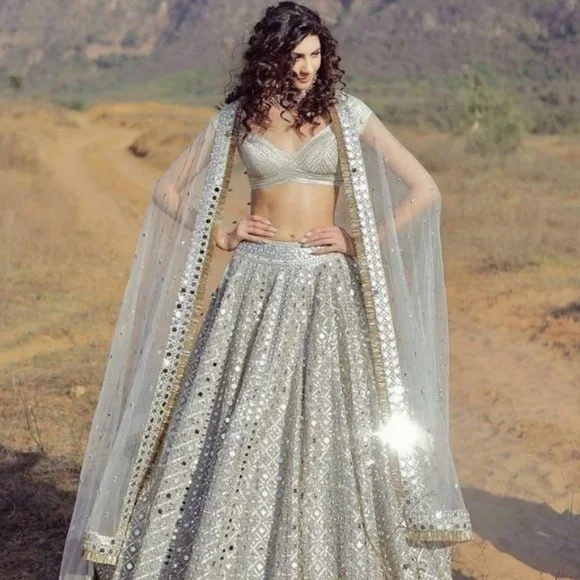
Pattern of a Mirror Work Ghagra:
The pattern of a Mirror Work Ghagra, a traditional Indian attire, is characterised by the intricate use of mirrors to embellish the ghagra, creating a stunning and visually captivating design. Here are the essential components of the pattern:
Mirror Placement: Small, reflective glass mirrors are meticulously hand-embroidered onto the fabric of the ghagra in a decorative pattern. These mirrors can vary in size and shape, with circular and square mirrors being the most common.
Mirror Work Designs: The mirrors are often arranged in geometric or floral motifs, creating a symmetrical and aesthetically pleasing design. These motifs can cover the entire ghagra or be concentrated around the waist, hemline, or other strategic areas.
Colour Palette: Mirror Work Ghagras are known for their vibrant and bold colour choices. The base fabric is typically a rich and bright colour, such as red, green, blue, or yellow, which provides a striking contrast to the mirror work.
Mastering Mirror Work Ghagra Styling tips:
Styling a Mirror Work Ghagra is a delightful way to showcase this traditional Indian attire while adding your unique touch. Here are some guidelines for styling it:
Choose Complementary Accessories:
Opt for traditional jewellery that complements the mirror work and the colour of your Ghagra. Statement earrings, a matching necklace, and bangles can enhance the overall look.
Hairstyle:
Select a hairstyle that suits your face shape and the occasion. You can choose to leave your hair open, style it in loose waves, or opt for an elegant updo. Decorative hair pins or hairpieces can be added for an extra touch of glamour.
Makeup:
Traditional Indian makeup with kohl-lined eyes, bold eyelashes, and bright lipstick often complements the Mirror Work Ghagra. Don’t forget to include intricate henna (mehndi) designs on your hands and feet, which are a beautiful and traditional addition.
Footwear:
Consider traditional Indian footwear like juttis, mojaris, or embellished sandals to complete your look. The footwear should coordinate with the colour and style of your outfit.
Dupatta Draping:
Drape the dupatta gracefully over one shoulder to complete the ensemble. You can pin it in place or use a decorative brooch to secure it.
Clutch or Potli Bag:
A traditional clutch or potli bag can be an elegant addition to your outfit, offering a place to carry essentials like your phone and makeup.
Anarkali Suit:
An Anarkali suit is a traditional Indian outfit known for its regal and graceful appearance. It features a floor-length frock-style kameez with a flared silhouette, often adorned with intricate embroidery and ornate details. Paired with churidar pants or leggings and a coordinating dupatta, the Anarkali suit is a popular choice for weddings, festivals, and other celebratory occasions. It beautifully blends traditional Indian aesthetics with contemporary style, making it a beloved attire that exudes timeless elegance.
Pattern of Anarkali Suit:
The pattern of an Anarkali suit is a fusion of traditional elegance and contemporary style, creating a stunning and versatile ensemble. Here are the key components that define the pattern of this attire:
Silhouette:
The Anarkali suit is characterised by its flowing, floor-length frock-style kameez (tunic). The silhouette is typically flared and offers a timeless, regal appearance. The skirt of the kameez can vary in its flared design, from a modest A-line to a voluminous and heavily pleated one.
Kameez Design:
The kameez, or top, is the focal point of the outfit. It is often heavily embellished with intricate embroidery, zari work, sequins, mirror work, and other ornate details. The embroidery can vary from traditional motifs to contemporary designs, and the choice of fabric influences the overall look.
Neckline and Sleeves:
Anarkali suits can feature various necklines, including boat neck, V-neck, or round neck, depending on personal preference. The sleeves may range from sleeveless to full-sleeved, with options for three-quarter or elbow-length sleeves. These variations allow for a customised appearance.
Dupatta:
Anarkali suits are typically paired with a coordinating or contrasting dupatta (scarf) that complements the outfit. The dupatta can be draped gracefully over one shoulder or allowed to flow freely, adding to the overall elegance.
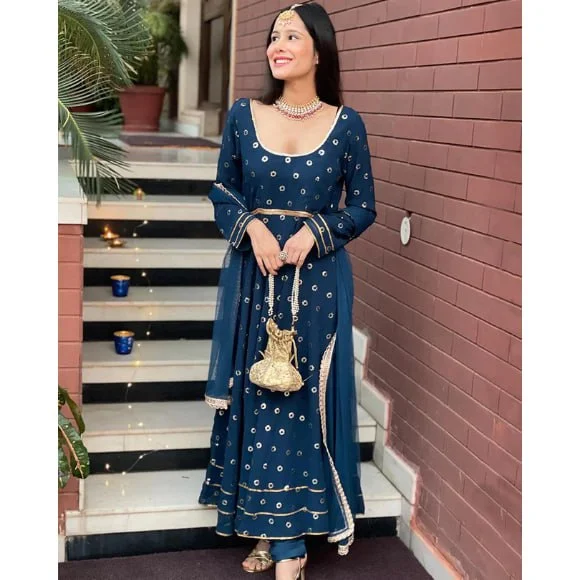
Elevate Your Anarkali Suit Style with These Tips
Styling an Anarkali suit is a delightful way to showcase its regal and graceful appearance. Here are steps on how to style it effectively:
- Select the Right Anarkali Suit:
Begin by choosing an Anarkali suit that suits the occasion, your body shape, and your personal style. Pay attention to the fabric, colour, and embellishments.
- Accessorise with Traditional Jewellery:
Traditional Indian jewellery complements the grandeur of an Anarkali suit. Opt for statement earrings, necklaces, bangles, and a maang tikka that coordinate with the outfit’s design and colour.
- Hairstyling:
Style your hair in a manner that complements the neckline and design of the Anarkali suit. You can choose from updos, loose curls, braids, or left-open hair, depending on your personal preference.
- Makeup:
Traditional Indian makeup, with kohl-lined eyes, bold lipstick, and well-defined features, is often an ideal choice. Enhance the look with henna (mehndi) designs on your hands and feet for a traditional touch.
- Footwear:
Select traditional Indian footwear, like juttis or embellished sandals, to complete the look. These complement the outfit and add to the overall traditional feel.
Dhoti Kurti Set:
The Dhoti Kurti Set is a captivating and versatile traditional Indian attire that encapsulates the essence of cultural heritage while exuding modern elegance. This ensemble consists of a dhoti, a timeless and comfortable bottom garment, and a kurti, a beautifully designed tunic-style top. Together, they create a distinctive and graceful look that has been cherished for generations.
The dhoti, a piece of unstitched fabric, is draped with pleats and a knot around the waist, while the kurti complements it with intricate embroidery, embellishments, or traditional prints. The combination of these two elements offers a delightful fusion of tradition and contemporary fashion.
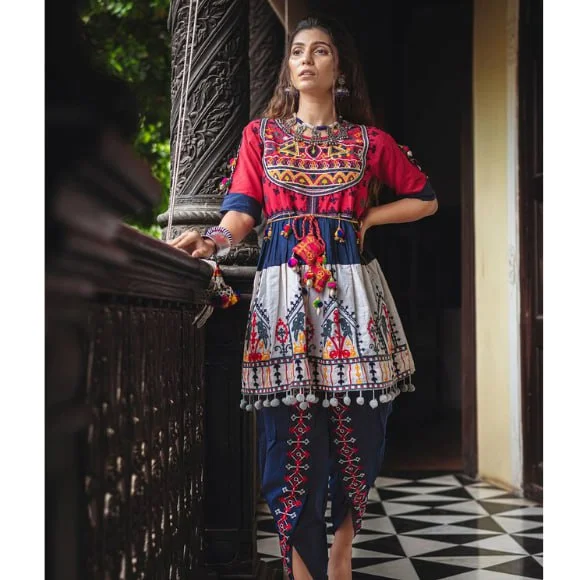
Pattern of Dhoti Kurti set:
The pattern of a Dhoti Kurti Set combines traditional and contemporary elements to create a unique and elegant ensemble. Here are the key components that define the pattern of this attire:
Dhoti:
The dhoti is a rectangular piece of unstitched fabric, typically cotton or silk, with a pattern that may include solid colours, traditional prints, or intricate motifs. It features pleats at the waist and is secured with a knot or drawstring, creating a comfortable and free-flowing lower garment.
Kurti:
The kurti is a tunic-style top with varying patterns, such as intricate embroidery, mirror work, zari (metallic thread) detailing, or traditional prints. The length of the kurti can vary from short to knee-length to floor-length, depending on personal style and the occasion.
Neckline and Sleeves:
Kurtis may have different necklines, including round, V-neck, boat neck, or square neck, and sleeves can range from sleeveless to full-sleeved. The pattern of the kurti’s neckline and sleeves may incorporate contrasting colours or complementary embroidery.
Styling Tips for the Dhoti Kurti Set:
The Dhoti Kurti Set is a versatile and elegant ensemble that allows for a range of styling options. Here are some tips to help you make the most of this traditional Indian attire:
Perfect Pairing:
Choose a Dhoti Kurti Set that complements your body type and the occasion. Pay attention to the fabric, colour, and pattern to ensure a well-coordinated look.
Accessorize Thoughtfully:
Traditional Indian jewellery, such as statement earrings, bangles, and a maang tikka, enhances the beauty of the Dhoti Kurti Set. Coordinate the accessories with the outfit’s design and colours.
Hairstyling:
Consider elegant hairstyles that complement the neckline and design of the kurti. Options include updos, braids, or leaving your hair open, depending on your personal style.
Makeup Magic:
Traditional Indian makeup often includes kohl-lined eyes, bold lipstick, and contouring to enhance your features. Don’t forget the bindi for a traditional touch.
Footwear Choices:
Select traditional Indian footwear like juttis, mojaris, or sandals to complete the look. Match the footwear with the outfit’s colours or choose contrasting options.
Bandhani Print Saree:
The Bandhani Print Saree is a vibrant and iconic symbol of Indian textile artistry, celebrated for its mesmerising patterns and rich cultural heritage. Bandhani, which translates to “to bind,” is a traditional tie-dye technique that creates intricate patterns of small, vibrant dots or “bindis” across the fabric. These dots are meticulously tied and dyed to achieve stunning designs, making Bandhani Print Sarees a work of art in themselves.
Hailing from the colourful and culturally diverse regions of India, particularly Rajasthan and Gujarat, these sarees have a history that dates back centuries. They are a testament to the exquisite craftsmanship of Indian artisans and the enduring appeal of traditional textile techniques.
Pattern of Bandhani Print Saree:
The pattern of a Bandhani Print Saree is a mesmerising display of intricate tie-dye work, resulting in a distinctive and vibrant design. Here are the key elements that define the pattern of a Bandhani Print Saree:
Bindis or Dots:
The defining feature of a Bandhani Print Saree is the intricate pattern of small, evenly spaced dots or “bindis” that cover the fabric’s surface. These dots are created using a meticulous tie-dye technique, where small portions of the fabric are tied with thread before dyeing, leaving uncoloured circles. The arrangement and density of these dots can vary, giving rise to different patterns and designs.
Colour Palette:
Bandhani Print Sarees come in a vibrant and rich colour palette, often featuring bold and contrasting hues. The choice of colours depends on regional traditions, personal preferences, and the occasion.
Geometric Patterns:
The dots are typically arranged in geometric patterns, which can include circles, squares, diamonds, or even more intricate shapes. These patterns are carefully designed, and artisans use their skill to create symmetrical and visually appealing designs.
Borders and Pallu:
Many Bandhani Print Sarees feature border designs with continuous or intermittent patterns, and the pallu (the decorative end of the saree) often carries an exquisite concentration of dots that create a captivating focal point.
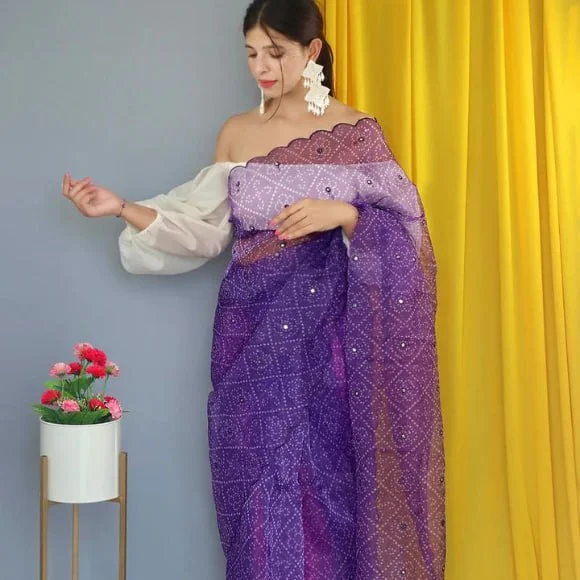
Styling Tips for Bandhani Print Sarees:
Bandhani Print Sarees are a celebration of vibrant patterns and rich heritage. To style them with grace and elegance, consider these tips:
Colour Coordination:
Choose your accessories, including jewellery and footwear, to complement the colours in the saree. Coordinating or contrasting shades can work beautifully.
Minimalist Jewellery:
Let the saree’s intricate patterns take centre stage. Opt for minimalist jewellery, like stud earrings and a delicate necklace, to maintain the focus on the saree.
Hair and Makeup:
Keep your hair and makeup simple to balance the bold patterns. Soft curls or a sleek bun with understated makeup is a great choice.
Blouse Design:
Select a blouse design that complements the saree’s patterns and colours. Boat necks, square necks, or simple designs often work well.
The Right Draping:
Ensure that the saree is draped neatly and securely. The pleats and pallu should highlight the patterns and not overpower them.
Accessories:
A bindi, bangles, and a clutch or potli bag can add a traditional touch. Choose accessories that align with the occasion.
Embroidered Sharara:
The Embroidered Sharara is a regal and elegant ensemble that epitomizes the grandeur of Indian fashion. This outfit combines traditional craftsmanship with modern design, resulting in a captivating and graceful attire that has captivated the hearts of fashion enthusiasts.
The Sharara, a flared trouser traditionally associated with North Indian and Pakistani culture, is at the heart of this ensemble. Its unique silhouette, characterised by wide and voluminous flared pants, offers both comfort and style. Paired with a beautifully embroidered kurta (tunic) and often complemented with a coordinating dupatta (scarf), the Embroidered Sharara is a statement of traditional opulence and contemporary chic.
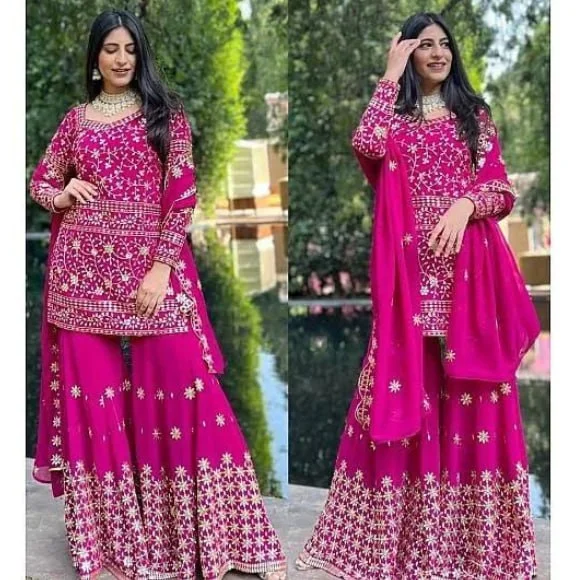
One of the most enchanting features of the Embroidered Sharara is the intricate embroidery that adorns the fabric. The embroidery work is a masterpiece of artistry, showcasing a variety of patterns, designs, and motifs, often enhanced with embellishments like zari (metallic thread), sequins, and beads. This embroidery elevates the ensemble, making it suitable for a range of occasions, from weddings and festive celebrations to formal gatherings.
The Embroidered Sharara is not just an outfit; it’s an embodiment of tradition, craftsmanship, and individual style. It reflects the diverse and rich cultural tapestry of the Indian subcontinent, showcasing the beauty of its textiles and design. This ensemble continues to be a symbol of grace and elegance, allowing wearers to immerse themselves in the opulence of traditional attire while embracing the modern era of fashion.
Pattern of Embroidered Sharara:
The pattern of an Embroidered Sharara is a visual delight, showcasing intricate and captivating embroidery work that enhances the overall elegance of the ensemble. Here are the key elements that define the pattern of an Embroidered Sharara:
Embroidery Motifs:
The primary feature of an Embroidered Sharara is the presence of meticulously embroidered motifs that adorn the fabric. These motifs can vary widely and may include floral patterns, geometric designs, paisley motifs, or intricate abstract shapes.
Embroidery Techniques:
The embroidery work can employ various techniques, such as zari (metallic thread) embroidery, resham (silk thread) embroidery, sequin work, beadwork, and mirror work. These techniques add depth, texture, and dimension to the patterns.
Placement of Embroidery:
Embroidery is strategically placed on the Sharara’s fabric, often along the hemline and border of the flared pants. The kurta (tunic) may also feature extensive embroidery on the yoke, sleeves, and neckline.
Colour Palette:
The colour palette for the embroidery may vary, depending on the base colour of the fabric. It often features complementary or contrasting shades to create a harmonious and visually appealing design.
Dupatta (Scarf):
An Embroidered Sharara ensemble may include a coordinating dupatta with matching or complementing embroidery. The dupatta often features a border that aligns with the pattern on the Sharara and kurta.
Intricate Detailing:
The patterns are characterized by their intricate detailing, which may include delicate stitches, fine threadwork, and embellishments like beads and sequins. These details enhance the overall grandeur of the ensemble.
Styling tips for Embroidered Sharara:
Styling an Embroidered Sharara is a delightful experience, combining tradition with contemporary chic. Here are some tips to help you make the most of this regal ensemble:
colour Coordination:
Choose accessories, including jewellery and footwear, that complement or contrast with the colours in the Sharara. The right colour harmony can elevate your overall look.
Statement jewellery:
The intricate embroidery on the Sharara calls for statement jewellery. Opt for chandelier earrings, a chunky necklace, and bangles to add opulence to the outfit.
Hairstyling:
Keep your hair elegant and well-groomed. Classic hairstyles like updos or soft waves work beautifully with the Sharara.
Makeup Magic:
A touch of traditional Indian makeup with kohl-lined eyes, bold lipstick, and shimmering eyeshadow can enhance your features. Don’t forget a bindi for that traditional touch.
Dupatta Draping:
If your Sharara ensemble includes a dupatta, drape it gracefully over your shoulders. You can experiment with different draping styles to add drama to the look.
Footwear:
Traditional Indian footwear like juttis, mojaris, or embellished sandals complements the ensemble perfectly.
Gota Patti Anarkali:
The Gota Patti Anarkali is a resplendent and timeless Indian attire that combines the grace of the Anarkali silhouette with the opulence of Gota Patti work. This enchanting ensemble is a symbol of tradition and artistry, beautifully blending heritage with contemporary fashion.
The Anarkali, with its flowing and flared design, serves as the canvas for the exquisite Gota Patti work. Gota Patti is a traditional Indian embroidery technique where pieces of gold or silver ribbon are carefully sewn onto the fabric to create intricate patterns and designs. The result is a stunning play of metallic embellishments against the backdrop of rich, vibrant fabrics.
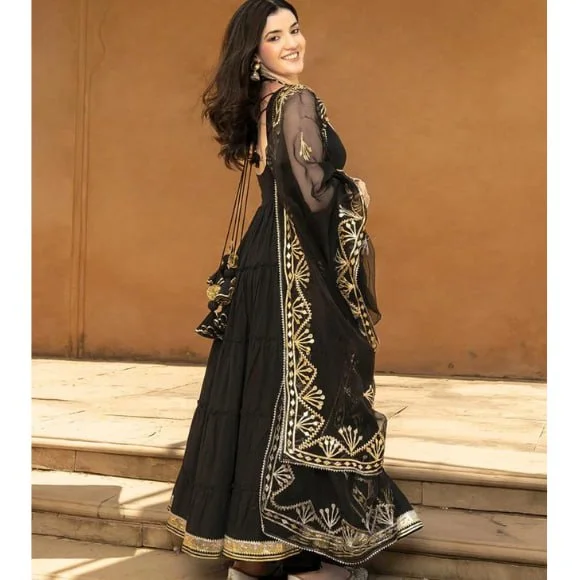
Gota Patti Anarkalis are cherished for their versatile elegance and are popular choices for weddings, festivals, and special occasions. The intricate Gota Patti embroidery, often featuring floral motifs, paisley patterns, and geometric designs, elevates the Anarkali to a work of art. This ensemble celebrates the craftsmanship of Indian artisans and reflects the richness of India’s textile and design traditions.
The Gota Patti Anarkali is not just clothing; it is a manifestation of culture, tradition, and individual style. It captures the essence of opulence and sophistication, allowing wearers to immerse themselves in the grandeur of Indian fashion while showcasing their personal grace and charm.
Pattern of Gota Patti Anarkali:
The pattern of a Gota Patti Anarkali is a splendid display of intricate embroidery and embellishments that elevate the elegance of the Anarkali silhouette. Here are the key elements that define the pattern of a Gota Patti Anarkali:
- Gota Patti Work:
The defining feature of a Gota Patti Anarkali is the extensive use of Gota Patti embroidery. Gota Patti involves intricate patterns created with thin strips of metallic ribbon, typically gold or silver in colour. These ribbons are sewn onto the fabric to form exquisite designs.
- Floral Motifs:
Many Gota Patti Anarkalis feature floral motifs, including roses, marigolds, and other blossoms. These motifs are meticulously crafted with Gota Patti to add a touch of nature’s beauty to the ensemble.
- Paisley Patterns:
Paisley patterns, a classic element in Indian textile design, are often incorporated into Gota Patti Anarkalis. These swirling, teardrop-shaped designs create a sense of grace and movement.
- Geometric Designs:
Some Gota Patti Anarkalis showcase geometric shapes, such as squares, circles, and triangles. These patterns can be arranged in symmetrical or asymmetrical formations.
Regal Glamour: Styling Tips for the Gota Patti Anarkali
Gota Patti Anarkalis are the epitome of grace and opulence. To style this regal ensemble with finesse, consider these tips:
- Complementary Jewellery:
Opt for traditional Indian jewellery that complements the Gota Patti work. Gold or silver jewellery with intricate designs, including chokers, jhumkas, and kadas, can enhance the opulence of the Anarkali.
- Minimalist Makeup:
Keep your makeup elegant and understated to balance the ornate Gota Patti embroidery. Soft eye makeup, nude or classic red lipstick, and a subtle bindi can add a traditional touch.
- Hairstyling:
Classic hairstyles like a bun, braids, or soft curls work beautifully with the Gota Patti Anarkali. You can accessorise with hairpins or fresh flowers.
- Dupatta Styling:
If your Anarkali ensemble includes a dupatta, drape it gracefully or pleat it neatly over your shoulder. You can also experiment with creative draping styles.
Silk Ghagra Choli:
The Silk Ghagra Choli is a timeless and regal ensemble that embodies the richness of Indian fashion and traditional craftsmanship. This exquisite attire comprises a ghagra, a voluminous and flared skirt, and a choli, a beautifully designed blouse, both meticulously crafted from luxurious silk fabric.
Silk has long been celebrated for its sheen, texture, and opulence, making it a coveted choice for special occasions and celebrations. The Silk Ghagra Choli elevates this fabric to new heights, showcasing its inherent beauty and versatility. The ghagra, with its wide and flowing silhouette, adds a touch of grandeur to the ensemble, while the intricately designed choli complements it with embroidery, embellishments, and artistic patterns.
One of the most enchanting features of the Silk Ghagra Choli is the choice of silk itself, which can range from silk varieties like Banarasi, Kanjeevaram, or raw silk, each offering its unique texture and allure. This ensemble is beloved for its versatility, making it suitable for weddings, festivals, grand celebrations, and formal gatherings.
The Silk Ghagra Choli is more than just clothing; it is a celebration of India’s diverse textile heritage, craftsmanship, and cultural grandeur. It reflects the elegance and richness of traditional Indian attire, allowing wearers to immerse themselves in the grandeur of silk while embracing the contemporary era of fashion.
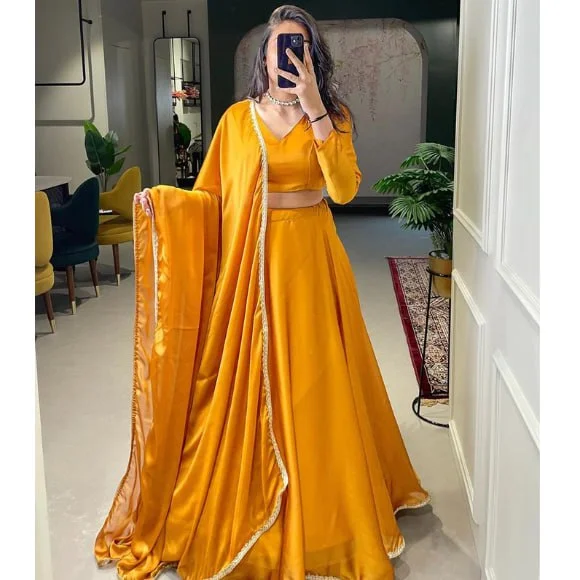
Pattern of Silk Ghagra Choli:
The pattern of a Silk Ghagra Choli is a stunning display of intricate design, artistic detailing, and the beauty of silk fabric. Here are the key elements that define the pattern of a Silk Ghagra Choli:
- Silk Varieties:
The choice of silk fabric can vary, including Banarasi silk, Kanjeevaram silk, raw silk, or other silk varieties. Each type offers a distinct texture and sheen, contributing to the overall look of the ensemble.
- Flared Ghagra:
The Ghagra (skirt) features a wide and voluminous flared design. The pattern may include gathers or pleats that create an elegant flow when worn.
- Choli Design:
The choli (blouse) is often intricately designed with patterns, embroidery, or embellishments. These designs can range from traditional motifs to contemporary artistic elements.
- Embroidery Techniques:
Various embroidery techniques, including zari (metallic thread) work, resham (silk thread) embroidery, sequins, and beadwork, are commonly used to embellish the choli and the ghagra.
Elegance in Silk: Styling Tips for the Ghagra Choli
Styling a Silk Ghagra Choli is a delightful experience, combining the grandeur of silk with the charm of traditional design. Here are some tips to help you create a regal and captivating look:
- Jewellery Selection:
Opt for traditional Indian jewellery that complements the Silk Ghagra Choli. Gold or antique jewellery with intricate designs, including choker necklaces, jhumkas, and bangles, can add opulence to your ensemble.
- Hair and Makeup:
A traditional Indian look with bold eye makeup, kohl-rimmed eyes, and vibrant lipstick can enhance your features. Accessorise with a bindi for a touch of authenticity.
- Hairstyling:
Classic hairstyles like a bun, braids, or soft curls work beautifully with the Silk Ghagra Choli. Consider adding hair accessories or fresh flowers for an extra touch of elegance.
- Dupatta Draping:
If your ensemble includes a dupatta, drape it gracefully over your shoulder or create unique draping styles to add drama to your look.
Contemporary Fusion Wear:
Contemporary Fusion Wear is a modern and versatile fashion trend that seamlessly blends elements from different cultures, styles, and eras to create innovative and unique ensembles. It represents a departure from traditional clothing boundaries and is characterised by its ability to infuse a sense of creativity, diversity, and individuality into fashion.
Contemporary Fusion Wear has gained popularity among those who seek to make a fashion statement that reflects their diverse and global outlook. It is an embodiment of fashion’s ability to evolve and adapt to changing tastes and sensibilities, allowing individuals to celebrate both tradition and modernity in their style choices.
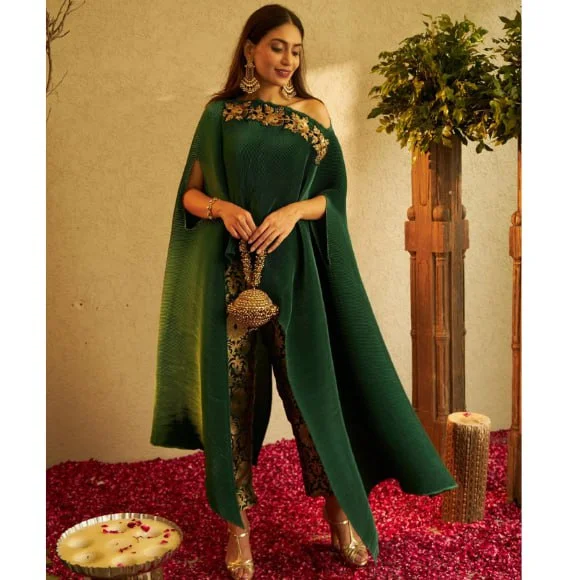
Pattern of Contemporary Fusion Wear:
The pattern of Contemporary Fusion Wear is characterised by a creative and eclectic blend of elements from different fashion traditions and cultures. Here are the key elements that define the pattern of Contemporary Fusion Wear:
- A mix of Fabrics:
Fusion Wear often combines fabrics from various traditions. For example, it may feature silk, chiffon, denim, or leather, creating a harmonious or contrasting mix of textures.
- Cultural Motifs:
This style may incorporate motifs, prints, and patterns from diverse cultures, including Indian, Asian, African, or Western. These motifs may be integrated into the fabric or embroidery.
- Versatile Silhouettes:
Fusion Wear embraces adaptable silhouettes that can be worn for different occasions. It features a variety of styles, from traditional Indian kurta and dhoti to modern dresses, tunics, and jumpsuits.
- Unconventional Pairings:
The hallmark of Fusion Wear is the combination of items that might not typically go together. This includes pairing a saree with a leather jacket, a kurta with jeans, or a Western blazer with traditional dhoti pants.
Innovative Elegance: Styling Tips for Contemporary Fusion Wear:
Styling Contemporary Fusion Wear is all about celebrating diversity and individuality. Here are some tips to help you create a distinctive and harmonious look:
- Balance is Key:
When mixing elements from different cultures and styles, aim for balance. If your outfit is heavily Indian-inspired, consider toning down the accessories or vice versa.
- Confidence and Comfort:
Wear Fusion Wear with confidence, and prioritize comfort. The key to carrying this style is feeling at ease in your outfit.
- Mix and Match:
Experiment with different pairings. Combine a traditional kurta with modern jeans, a saree with sneakers, or a Western blazer with ethnic dhoti pants.
- Statement Accessories:
Elevate your look with statement accessories. Bold jewellery, belts, scarves, or turbans can add character to your ensemble.
- Versatile Footwear:
Choose footwear that complements your outfit. Traditional juttis or mojaris, as well as modern sandals or sneakers, can work seamlessly with Fusion Wear.
- colour Coordination:
Pay attention to colour coordination. Ensure that the colours in your outfit harmonize with one another and that the ensemble as a whole is visually appealing.
